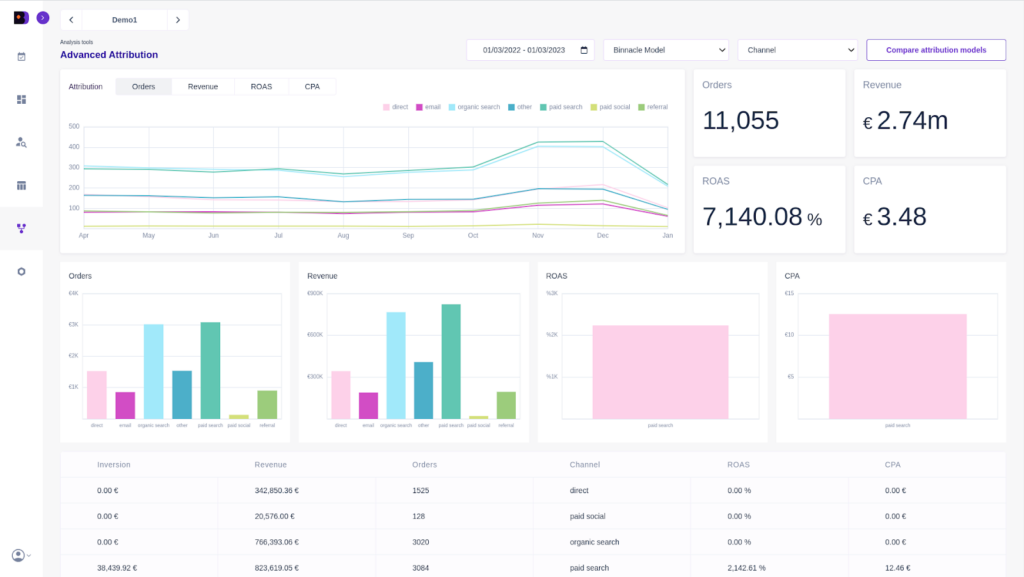
How to achieve a custom attribution model?
It’s common to have doubts about how to reach your clients and how to transform users into potential customers. Thanks to attribution models you will be able to measure the web page conversions and make informed decisions that allow efficient optimization of the conversion flows of the multiple digital channels.
Data is key to succeed with an attribution model. Keep reading to learn about its features and how to use your customers data to personalize them!
What is an attribution model?
An attribution model is a set of rules through which a value is assigned to the different channels that a user has gone through before conversion. Conversion is considered the action that the user has carried out on the web (a purchase, a subscription, filling in a contact form, etc.).
The monitoring occurs from the moment a user enters the web or app, until they finally buy a product. A value is assigned to each channel a customer has gone through until the conversion is carried out.
The journey of a user from the moment they reach the landing page until they perform an action that we consider to be a conversion is called the customer journey. This varies depending on the user, it is not common for several users to follow the same customer journey. We also found differences depending on the service offered to customers.
Attribution models can help different departments of a business, but some of the most benefited are marketing and the digital area.
Each model distributes the value of conversions differently. Depending on the objectives of your company, the different conversions will have more or less value. Some of the best known and used attribution models are:
- Last interaction attribution: the “last click” model gives value to the last interaction that a client or user had before the conversion.
- First interaction attribution: instead, this model focuses on that first click, or that first user interaction.
- Last indirect click: It is very similar to the last click model but in this case any direct interaction that occurred just before the conversion is removed. This nuance makes it more useful.
- Linear attribution:.This model assigns the same conversion value to all the channels through which the user passes on his customer journey. The value of a conversion is divided equally to all the channels through which it has passed
- Timing deterioration attribution: Just like the previous model, it gives value to all channels of the customer journey, but with one difference, the value increases according to the interaction that occurred closer to the moment of conversion. The Time Decay model takes into consideration when each contact point occurred.
- Attribution by position: in this case the value is divided between the first interaction and the last one.
These models are characterized by using a set of fixed and non-customizable attribution rules. This makes it possible to obtain models that are easy to calculate, but that do not always adapt to the idiosyncrasies of each business and that, in general, are ‘unfair’ when assessing the contribution of the different channels that participate in a conversion.
There is a category of advanced attribution models, also known as data-driven, such as the Shapley value attribution model or the Markov chain-based attribution model that, unlike the previous ones, use mathematical models that adjust automatically to the data of each business.

Binnacle Data, our data-driven tool, has its own attribution model based on Markov chains, also allowing the use of the most classic models (last click, first click and linear). Binnacle Data automatically adjusts its attribution model to the data of each business through a process of analysis and automatic training based on the different conversion paths of a digital business. This allows you to obtain personalized attribution models for each business and is capable of offering a fairer and more reliable interpretation of the value provided by each of the acquisition channels.
How to choose the best attribution model?
There are many types of attribution models, each one has its advantages and disadvantages and in many cases they are not as accurate as one would like. That is why it is essential to choose the model that adapts the best to the business needs and objectives, but how do you know which one fits?
The first thing to do is analyze the customer journey of clients on the web or app to see what type of model would fit best. A customer journey in which customers make the decision at the last moment, even impulsively, (such as ordering food at home) is not the same as those in which it is longer, where the customer follows a process to consider the purchase.
It is likely that even having analyzed the above, you still have doubts about which model is best suited. That is why Binnacle Data allows you to use four different attribution models (markov, last-click, first-click and linear) and compare them based on the real data of your business. This tool allows you to use all of them simultaneously and switch from one to another in order to compare them.
Why have one when you can have them all and compare them?
In the following figure we show you how the comparison of models is presented:

To evaluate the results and find the model that best suits the objectives and the business, you can experiment by increasing or decreasing the budget of some of the channels and see what consequences it has on the results. Although to do this with knowledge of the facts, the first thing will be to find the best attribution model for the business.
You will have noticed that for the effectiveness and success of all of the above, good data management is key. Quality and real data in which you can support the entire strategy. Without complete data that adjusts as close as possible to reality, you will not obtain the expected results after applying the attribution model.
For data management and analysis, there are several tools that can help you, one of which is Binnacle Data, an analytical solution that allows you to integrate and cross-reference all your data in one place. This tool uses a data-driven attribution model, so you can easily and accurately obtain a personalized model based on your needs and objectives. The data-driven tool that allows you to get the most out of your business.
How to get a personalized attribution model?
As we have mentioned before, attribution models follow predetermined guidelines, but to ensure success they must be customized. Depending on the business and the journey of the clients, there are some needs or others to be able to achieve your goal.
When ecommerce is complex and is based on a standard model, it is very likely that great business opportunities are lost. Not identifying the real value of the data or not obtaining realistic and effective data will cause you to miss the objectives.
Depending on the objective, there will be conversions and points of contact with the customers that are more valuable, you have to identify them and create a model based on that.
The Shapley or Markov model greatly simplifies this task. They are complete and dynamic attribution models that allow you to obtain more complete results. Binnacle Data is based on these data-driven models to be able to present accurate results adapted to each business.
On the other hand, as we have mentioned before, it is critical to obtain and manage data from the different channels. Using a tool like Redegal’s Binnacle Data that allows you to get accurate and consistent custom data is a good start. If you want to know how this tool works and what it can contribute to your business, ask us!
Thanks to this type of tools you will be able to adapt and customize the attribution models based on the data obtained.
To obtain more information about this tool or ask us any questions, do not hesitate to contact us! 🙂



